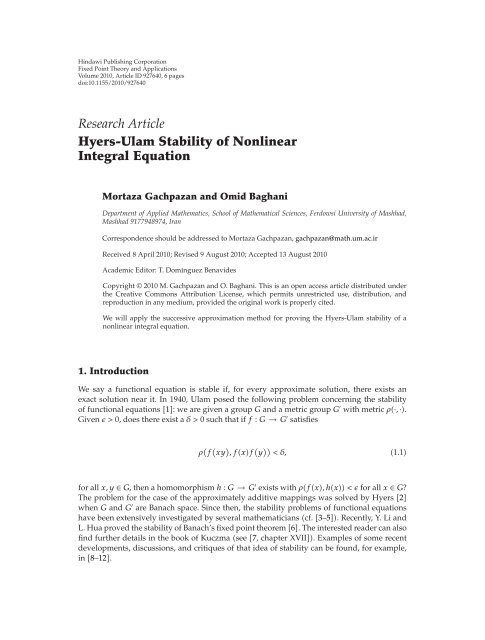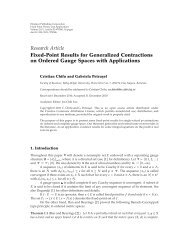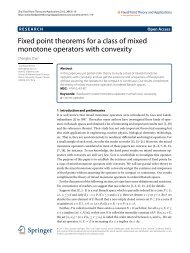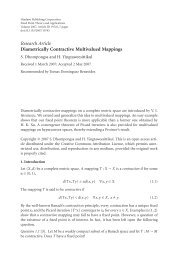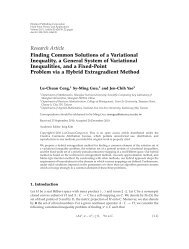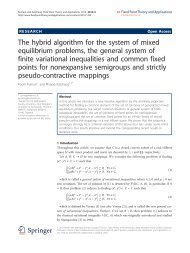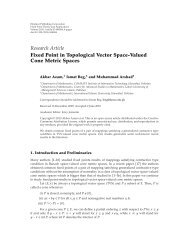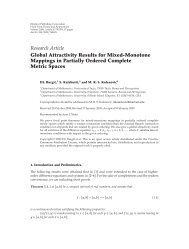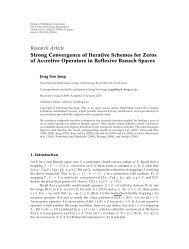Hyers-Ulam Stability of Nonlinear Integral Equation - Fixed Point ...
Hyers-Ulam Stability of Nonlinear Integral Equation - Fixed Point ...
Hyers-Ulam Stability of Nonlinear Integral Equation - Fixed Point ...
You also want an ePaper? Increase the reach of your titles
YUMPU automatically turns print PDFs into web optimized ePapers that Google loves.
Hindawi Publishing Corporation<br />
<strong>Fixed</strong> <strong>Point</strong> Theory and Applications<br />
Volume 2010, Article ID 927640, 6 pages<br />
doi:10.1155/2010/927640<br />
Research Article<br />
<strong>Hyers</strong>-<strong>Ulam</strong> <strong>Stability</strong> <strong>of</strong> <strong>Nonlinear</strong><br />
<strong>Integral</strong> <strong>Equation</strong><br />
Mortaza Gachpazan and Omid Baghani<br />
Department <strong>of</strong> Applied Mathematics, School <strong>of</strong> Mathematical Sciences, Ferdowsi University <strong>of</strong> Mashhad,<br />
Mashhad 9177948974, Iran<br />
Correspondence should be addressed to Mortaza Gachpazan, gachpazan@math.um.ac.ir<br />
Received 8 April 2010; Revised 9 August 2010; Accepted 13 August 2010<br />
Academic Editor: T. Domínguez Benavides<br />
Copyright q 2010 M. Gachpazan and O. Baghani. This is an open access article distributed under<br />
the Creative Commons Attribution License, which permits unrestricted use, distribution, and<br />
reproduction in any medium, provided the original work is properly cited.<br />
We will apply the successive approximation method for proving the <strong>Hyers</strong>-<strong>Ulam</strong> stability <strong>of</strong> a<br />
nonlinear integral equation.<br />
1. Introduction<br />
We say a functional equation is stable if, for every approximate solution, there exists an<br />
exact solution near it. In 1940, <strong>Ulam</strong> posed the following problem concerning the stability<br />
<strong>of</strong> functional equations 1: we are given a group G and a metric group G ′ with metric ρ·, ·.<br />
Given ɛ>0, does there exist a δ>0 such that if f : G → G ′ satisfies<br />
ρ f xy ,fxf y
2 <strong>Fixed</strong> <strong>Point</strong> Theory and Applications<br />
In this paper, we study the <strong>Hyers</strong>-<strong>Ulam</strong> stability for the nonlinear Volterra integral<br />
equation <strong>of</strong> second kind. Jung was the author who investigated the <strong>Hyers</strong>-<strong>Ulam</strong> stability <strong>of</strong><br />
Volterra integral equation on any compact interval. In 2007, he proved the following 13.<br />
Given a ∈ R and r>0, let Ia; r denote a closed interval {x ∈ R | a − r ≤ x ≤ a r}<br />
and let f : Ia; r × C → C be a continuous function which satisfies a Lipschitz condition<br />
|fx, y − fx, z| ≤ L|y − z| for all x ∈ Ia; r and y, z ∈ C, where L is a constant with<br />
0
<strong>Fixed</strong> <strong>Point</strong> Theory and Applications 3<br />
then there exists some u ∈ X satisfying ux fxϕ x<br />
Fx, t, utdt such that<br />
a<br />
<br />
ux − yx ≤ Kɛ. 2.2<br />
We call such K a <strong>Hyers</strong>-<strong>Ulam</strong> stability constant for 1.4.<br />
3. Existence <strong>of</strong> the Solution <strong>of</strong> <strong>Nonlinear</strong> <strong>Integral</strong> <strong>Equation</strong>s<br />
Consider the iterative scheme<br />
un1x fx ϕ<br />
x<br />
a<br />
<br />
Fx, t, untdt ≡ Tun, n 1, 2,.... 3.1<br />
Since Fx, t, ut is assumed Lipschitz, we can write<br />
<br />
<br />
|un1x − unx| <br />
ϕ x<br />
x<br />
<br />
<br />
Fx, t, untdt − ϕ Fx, t, un−1tdt<br />
a<br />
a<br />
<br />
<br />
<br />
ϕ x<br />
x<br />
<br />
<br />
Fx, t, untdt − Fx, t, un−1tdt<br />
a<br />
a<br />
≤ <br />
x<br />
ϕ |Fx, t, unt − Fx, t, un−1t|dt<br />
a<br />
≤ <br />
x<br />
ϕL |unt − un−1t|dt.<br />
a<br />
Hence,<br />
|un1x − unx| ≤ <br />
x<br />
ϕL |unt1 − un−1t1|dt1<br />
a<br />
.<br />
≤ ϕ L 2<br />
≤ ϕ L n−1<br />
x t1<br />
a<br />
a<br />
x t1<br />
a<br />
|un−1t2 − un−2t2|dt2 dt1<br />
a<br />
···<br />
≤ ϕ L n−1dTu1,u1<br />
tn−2<br />
a<br />
x t1<br />
a<br />
|u2tn−1 − u1tn−1|dtn−1 ···dt2 dt1<br />
a<br />
tn−2<br />
··· dtn−1 ···dt2 dt1,<br />
a<br />
in which df, g maxx∈a,b|fx − gx|, for all f, g ∈ Ca, b. So, we can write<br />
|un1x − unx| ≤ ϕ L n−1 x − a n−1<br />
n − 1! dTu1,u1.<br />
3.2<br />
3.3<br />
3.4
4 <strong>Fixed</strong> <strong>Point</strong> Theory and Applications<br />
Therefore, since x is complete metric space, if u1 ∈ X, then<br />
∞<br />
un1x − unx 3.5<br />
n1<br />
is absolutely and uniformly convergent by Weirstrass’s M-test theorem. On the other hand,<br />
unx can be written as follows:<br />
n−1<br />
unx u1x uk1x − ukx. 3.6<br />
k1<br />
So there exists a unique solution u ∈ X such that limn →∞unx u. Now by taking the limit<br />
<strong>of</strong> both sides <strong>of</strong> 3.1, we have<br />
<br />
u lim un1x lim fx ϕ<br />
n →∞ n →∞<br />
fx ϕ<br />
fx ϕ<br />
x<br />
a<br />
x<br />
x<br />
So, there exists a unique solution u ∈ X such that Tu u.<br />
4. Main Results<br />
a<br />
a<br />
<br />
Fx, t, untdt<br />
<br />
<br />
F x, t, lim unt<br />
n →∞<br />
<br />
dt<br />
Fx, t, utdt .<br />
In this section, we prove that the nonlinear integral equation in 1.4 has the <strong>Hyers</strong>-<strong>Ulam</strong><br />
stability.<br />
Theorem 4.1. The equation Tx x, whereT is defined by 1.4, has the <strong>Hyers</strong>-<strong>Ulam</strong> stability; that<br />
is, for every ξ ∈ X and ɛ>0 with<br />
there exists a unique u ∈ X such that<br />
for some K ≥ 0.<br />
3.7<br />
dTξ,ξ ≤ ɛ, 4.1<br />
Tu u,<br />
dξ, u ≤ Kɛ,<br />
Pro<strong>of</strong>. Let ξ ∈ X, ɛ>0, and dTξ,ξ ≤ ɛ. In the previous section we have proved that<br />
4.2<br />
ut ≡ lim<br />
n →∞ T n ξt 4.3
<strong>Fixed</strong> <strong>Point</strong> Theory and Applications 5<br />
is an exact solution <strong>of</strong> the equation Tx x. Clearly there is n with dT n ξ, u ≤ ɛ, because T n ξ<br />
is uniformly convergent to u as n →∞.Thus<br />
dξ, u ≤ dξ, T n ξ dT n ξ, u<br />
<br />
≤ dξ, Tξ d Tξ,T 2 <br />
ξ<br />
<br />
d T 2 ξ, T 3 <br />
ξ ··· d T n−1 ξ, T n <br />
ξ dT n ξ, u<br />
≤ dξ, Tξ k k2<br />
kn−1<br />
dξ, Tξ dξ, Tξ ···<br />
1! 2! n − 1! dξ, Tξ dT n ξ, u<br />
<br />
≤ dξ, Tξ 1 k<br />
<br />
k2 kn−1<br />
··· ɛ<br />
1! 2! n − 1!<br />
<br />
≤ ɛ e k<br />
<br />
ɛ 1 e k<br />
ɛ,<br />
where k ϕLb − a. This completes the pro<strong>of</strong>.<br />
Corollary 4.2. For infinite interval, Theorem 4.1 is not true necessarily. For example, the exact<br />
solution <strong>of</strong> the integral equation ux 1 x<br />
a utdt ≡ Tu, x ∈ 0, ∞, isux ex . By choosing<br />
ɛ 1 and ξx 0, Tξ 1 is obtained, so dTξ,ξ ≤ ɛ 1, dξ, u ∞. Hence, there exists no<br />
<strong>Hyers</strong>-<strong>Ulam</strong> stability constant K ≥ 0 such that the relation dξ, u ≤ Kɛ is true.<br />
Corollary 4.3. Theorem 4.1 holds for every finite interval a, b, a, b, a, b, and a, b,<br />
when −∞
6 <strong>Fixed</strong> <strong>Point</strong> Theory and Applications<br />
6. Ideas<br />
In this paper, we proved that 1.4 has the <strong>Hyers</strong>-<strong>Ulam</strong> stability. In 1.4, ϕ is a linear<br />
transformation. It is an open problem that raises the following question: “What can we say<br />
about the <strong>Hyers</strong>-<strong>Ulam</strong> stability <strong>of</strong> the general nonlinear Volterra integral equation 1.4 when<br />
ϕ is not necessarily linear?”<br />
References<br />
1 S. M. <strong>Ulam</strong>, Problems in Modern Mathematics, Chapter 6, John Wiley & Sons, New York, NY, USA, 1960.<br />
2 D. H. <strong>Hyers</strong>, “On the stability <strong>of</strong> the linear functional equation,” Proceedings <strong>of</strong> the National Academy <strong>of</strong><br />
Sciences <strong>of</strong> the United States <strong>of</strong> America, vol. 27, pp. 222–224, 1941.<br />
3 S.-M. Jung, “<strong>Hyers</strong>—<strong>Ulam</strong> stability <strong>of</strong> differential equation y ′′<br />
2xy ′ − 2ny 0,” Journal <strong>of</strong> Inequalities<br />
and Applications, vol. 2010, Article ID 793197, 12 pages, 2010.<br />
4 S.-E. Takahasi, T. Miura, and S. Miyajima, “On the <strong>Hyers</strong>—<strong>Ulam</strong> stability <strong>of</strong> the Banach space-valued<br />
differential equation y ′ λy,” Bulletin <strong>of</strong> the Korean Mathematical Society, vol. 39, no. 2, pp. 309–315,<br />
2002.<br />
5 G. Wang, M. Zhou, and L. Sun, “<strong>Hyers</strong>—<strong>Ulam</strong> stability <strong>of</strong> linear differential equations <strong>of</strong> first order,”<br />
Applied Mathematics Letters, vol. 21, no. 10, pp. 1024–1028, 2008.<br />
6 Y. Li and L. Hua, “<strong>Hyers</strong>—<strong>Ulam</strong> stability <strong>of</strong> a polynomial equation,” Banach Journal <strong>of</strong> Mathematical<br />
Analysis, vol. 3, no. 2, pp. 86–90, 2009.<br />
7 M. Kuczma, An Introduction to the Theory <strong>of</strong> Functional <strong>Equation</strong>s and Inequalities, PMN, Warsaw, Poland,<br />
1985.<br />
8 J. Brzde¸k, “On a method <strong>of</strong> proving the <strong>Hyers</strong>—<strong>Ulam</strong> stability <strong>of</strong> functional equations on restricted<br />
domains,” The Australian Journal <strong>of</strong> Mathematical Analysis and Applications, vol. 6, no. 1, article 4, pp.<br />
1–10, 2009.<br />
9 K. Ciepliński, “<strong>Stability</strong> <strong>of</strong> the multi-Jensen equation,” Journal <strong>of</strong> Mathematical Analysis and<br />
Applications, vol. 363, no. 1, pp. 249–254, 2010.<br />
10 Z. Moszner, “On the stability <strong>of</strong> functional equations,” Aequationes Mathematicae, vol. 77, no. 1-2, pp.<br />
33–88, 2009.<br />
11 B. Paneah, “A new approach to the stability <strong>of</strong> linear functional operators,” Aequationes Mathematicae,<br />
vol. 78, no. 1-2, pp. 45–61, 2009.<br />
12 W. Prager and J. Schwaiger, “<strong>Stability</strong> <strong>of</strong> the multi-Jensen equation,” Bulletin <strong>of</strong> the Korean Mathematical<br />
Society, vol. 45, no. 1, pp. 133–142, 2008.<br />
13 S.-M. Jung, “A fixed point approach to the stability <strong>of</strong> a Volterra integral equation,” <strong>Fixed</strong> <strong>Point</strong> Theory<br />
and Applications, vol. 2007, Article ID 57064, 9 pages, 2007.<br />
14 M. Gachpazan and O. Baghani, “<strong>Hyers</strong><strong>Ulam</strong> stability <strong>of</strong> Volterra integral equation,” Journal <strong>of</strong><br />
<strong>Nonlinear</strong> Analysis and Its Applications, no. 2, pp. 19–25, 2010.<br />
15 G. B. Folland, Real Analysis Modern Techniques and Their Application, University <strong>of</strong> Washington, Seattle,<br />
Wash, USA, 1984.


